Management of Change: Employee Resistance, Power, and Ethics
VerifiedAdded on 2020/03/16
|10
|2811
|153
Essay
AI Summary
This essay delves into the complexities of change management within organizations, exploring the reasons behind employee resistance and its implications. It examines why managers often view resistance as a problem and the ethical dimensions involved. The paper analyzes factors contributing to employee resistance, such as fear of failure, poor change management, and the fear of the unknown. It investigates the relationship between power and resistance, highlighting how power dynamics influence employee acceptance or rejection of change initiatives. Furthermore, the essay addresses key ethical issues associated with power and resistance, emphasizing the importance of fair treatment and transparency in the change process. Finally, it discusses the impact of managerial and resistant positions on the effectiveness of change management programs, underscoring the importance of addressing resistance to achieve organizational goals. The essay emphasizes the need for managers to foster a supportive environment where employees feel valued and informed during times of change.
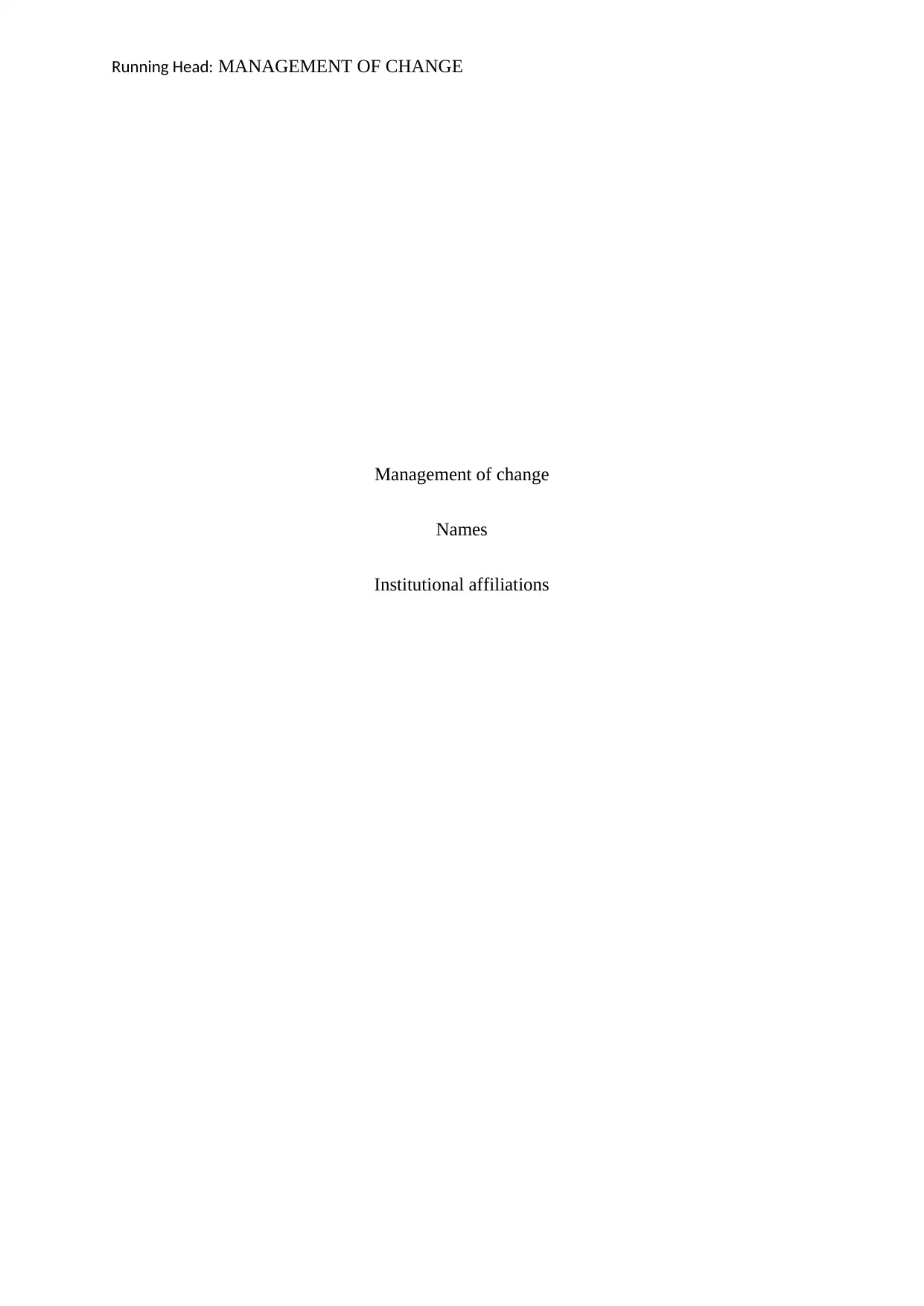
Running Head: MANAGEMENT OF CHANGE
Management of change
Names
Institutional affiliations
Management of change
Names
Institutional affiliations
Paraphrase This Document
Need a fresh take? Get an instant paraphrase of this document with our AI Paraphraser
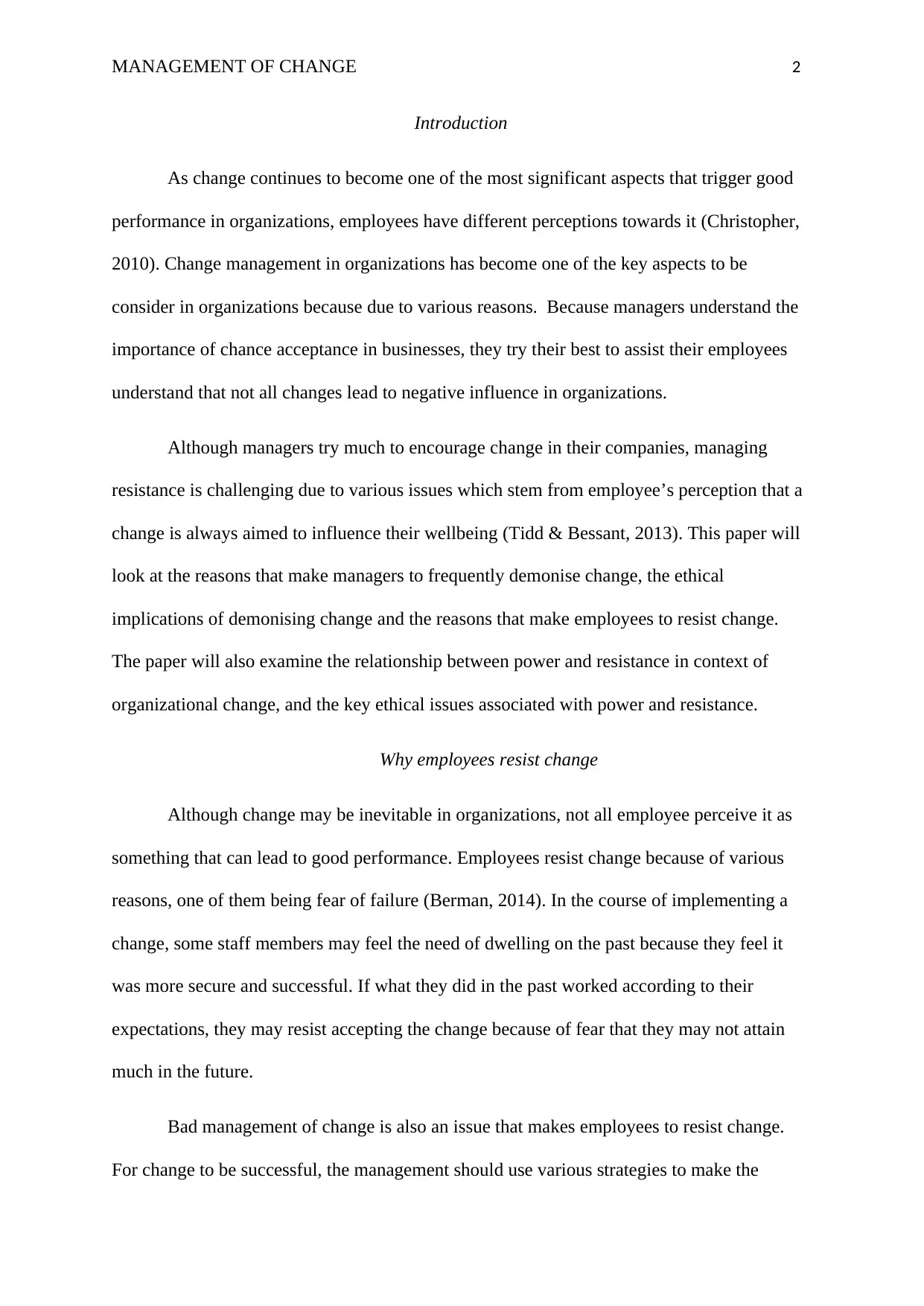
MANAGEMENT OF CHANGE 2
Introduction
As change continues to become one of the most significant aspects that trigger good
performance in organizations, employees have different perceptions towards it (Christopher,
2010). Change management in organizations has become one of the key aspects to be
consider in organizations because due to various reasons. Because managers understand the
importance of chance acceptance in businesses, they try their best to assist their employees
understand that not all changes lead to negative influence in organizations.
Although managers try much to encourage change in their companies, managing
resistance is challenging due to various issues which stem from employee’s perception that a
change is always aimed to influence their wellbeing (Tidd & Bessant, 2013). This paper will
look at the reasons that make managers to frequently demonise change, the ethical
implications of demonising change and the reasons that make employees to resist change.
The paper will also examine the relationship between power and resistance in context of
organizational change, and the key ethical issues associated with power and resistance.
Why employees resist change
Although change may be inevitable in organizations, not all employee perceive it as
something that can lead to good performance. Employees resist change because of various
reasons, one of them being fear of failure (Berman, 2014). In the course of implementing a
change, some staff members may feel the need of dwelling on the past because they feel it
was more secure and successful. If what they did in the past worked according to their
expectations, they may resist accepting the change because of fear that they may not attain
much in the future.
Bad management of change is also an issue that makes employees to resist change.
For change to be successful, the management should use various strategies to make the
Introduction
As change continues to become one of the most significant aspects that trigger good
performance in organizations, employees have different perceptions towards it (Christopher,
2010). Change management in organizations has become one of the key aspects to be
consider in organizations because due to various reasons. Because managers understand the
importance of chance acceptance in businesses, they try their best to assist their employees
understand that not all changes lead to negative influence in organizations.
Although managers try much to encourage change in their companies, managing
resistance is challenging due to various issues which stem from employee’s perception that a
change is always aimed to influence their wellbeing (Tidd & Bessant, 2013). This paper will
look at the reasons that make managers to frequently demonise change, the ethical
implications of demonising change and the reasons that make employees to resist change.
The paper will also examine the relationship between power and resistance in context of
organizational change, and the key ethical issues associated with power and resistance.
Why employees resist change
Although change may be inevitable in organizations, not all employee perceive it as
something that can lead to good performance. Employees resist change because of various
reasons, one of them being fear of failure (Berman, 2014). In the course of implementing a
change, some staff members may feel the need of dwelling on the past because they feel it
was more secure and successful. If what they did in the past worked according to their
expectations, they may resist accepting the change because of fear that they may not attain
much in the future.
Bad management of change is also an issue that makes employees to resist change.
For change to be successful, the management should use various strategies to make the
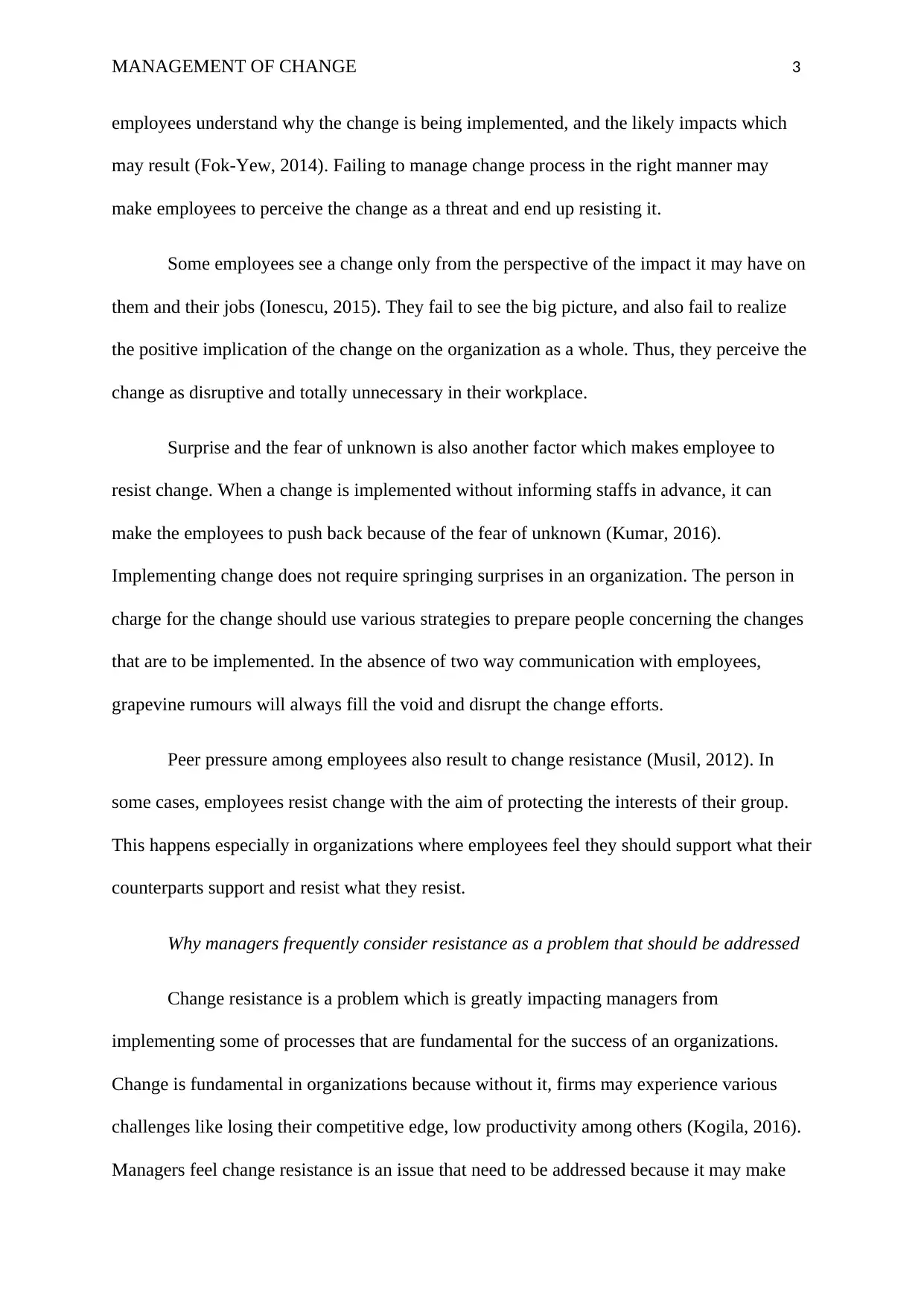
MANAGEMENT OF CHANGE 3
employees understand why the change is being implemented, and the likely impacts which
may result (Fok-Yew, 2014). Failing to manage change process in the right manner may
make employees to perceive the change as a threat and end up resisting it.
Some employees see a change only from the perspective of the impact it may have on
them and their jobs (Ionescu, 2015). They fail to see the big picture, and also fail to realize
the positive implication of the change on the organization as a whole. Thus, they perceive the
change as disruptive and totally unnecessary in their workplace.
Surprise and the fear of unknown is also another factor which makes employee to
resist change. When a change is implemented without informing staffs in advance, it can
make the employees to push back because of the fear of unknown (Kumar, 2016).
Implementing change does not require springing surprises in an organization. The person in
charge for the change should use various strategies to prepare people concerning the changes
that are to be implemented. In the absence of two way communication with employees,
grapevine rumours will always fill the void and disrupt the change efforts.
Peer pressure among employees also result to change resistance (Musil, 2012). In
some cases, employees resist change with the aim of protecting the interests of their group.
This happens especially in organizations where employees feel they should support what their
counterparts support and resist what they resist.
Why managers frequently consider resistance as a problem that should be addressed
Change resistance is a problem which is greatly impacting managers from
implementing some of processes that are fundamental for the success of an organizations.
Change is fundamental in organizations because without it, firms may experience various
challenges like losing their competitive edge, low productivity among others (Kogila, 2016).
Managers feel change resistance is an issue that need to be addressed because it may make
employees understand why the change is being implemented, and the likely impacts which
may result (Fok-Yew, 2014). Failing to manage change process in the right manner may
make employees to perceive the change as a threat and end up resisting it.
Some employees see a change only from the perspective of the impact it may have on
them and their jobs (Ionescu, 2015). They fail to see the big picture, and also fail to realize
the positive implication of the change on the organization as a whole. Thus, they perceive the
change as disruptive and totally unnecessary in their workplace.
Surprise and the fear of unknown is also another factor which makes employee to
resist change. When a change is implemented without informing staffs in advance, it can
make the employees to push back because of the fear of unknown (Kumar, 2016).
Implementing change does not require springing surprises in an organization. The person in
charge for the change should use various strategies to prepare people concerning the changes
that are to be implemented. In the absence of two way communication with employees,
grapevine rumours will always fill the void and disrupt the change efforts.
Peer pressure among employees also result to change resistance (Musil, 2012). In
some cases, employees resist change with the aim of protecting the interests of their group.
This happens especially in organizations where employees feel they should support what their
counterparts support and resist what they resist.
Why managers frequently consider resistance as a problem that should be addressed
Change resistance is a problem which is greatly impacting managers from
implementing some of processes that are fundamental for the success of an organizations.
Change is fundamental in organizations because without it, firms may experience various
challenges like losing their competitive edge, low productivity among others (Kogila, 2016).
Managers feel change resistance is an issue that need to be addressed because it may make
⊘ This is a preview!⊘
Do you want full access?
Subscribe today to unlock all pages.

Trusted by 1+ million students worldwide
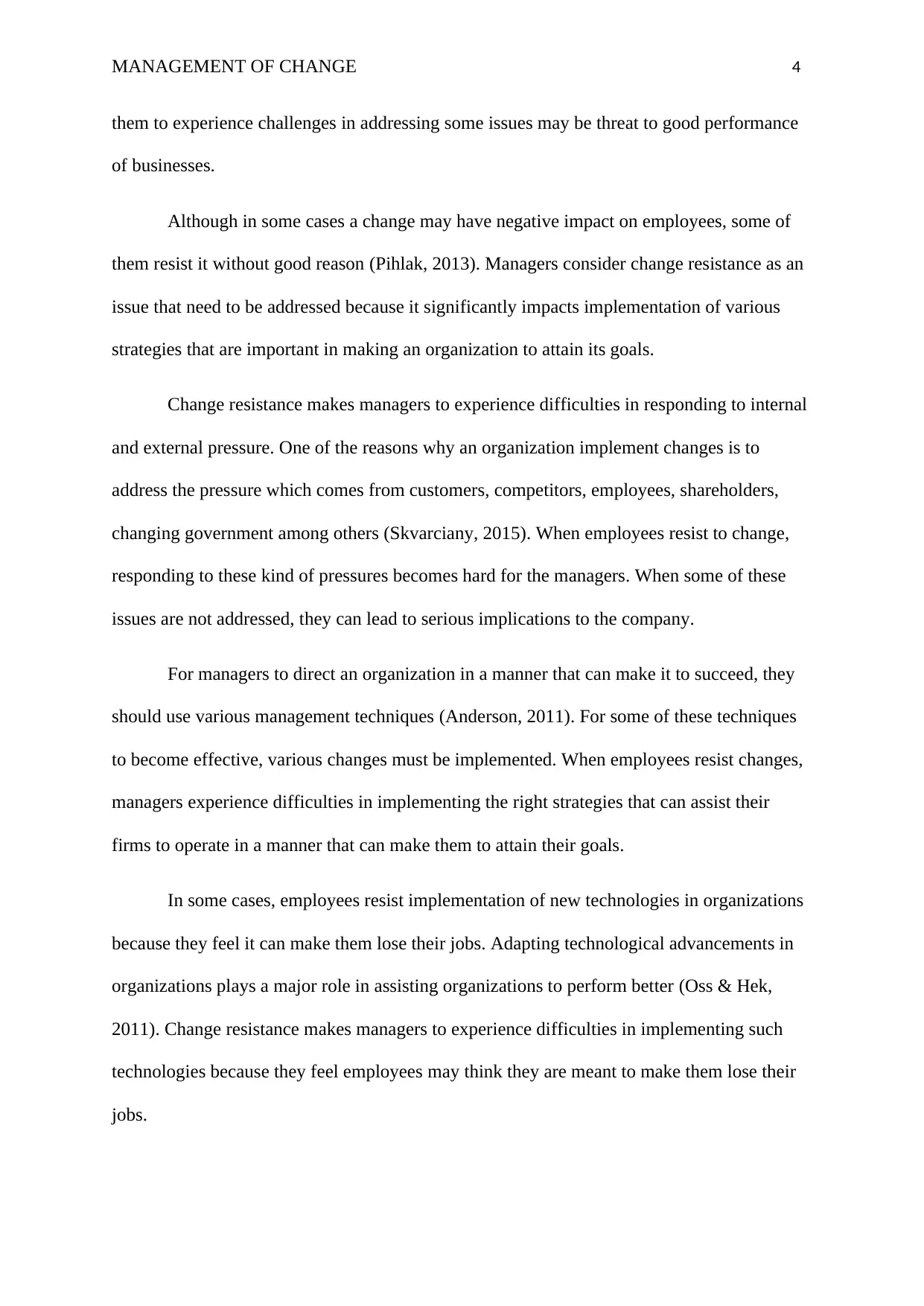
MANAGEMENT OF CHANGE 4
them to experience challenges in addressing some issues may be threat to good performance
of businesses.
Although in some cases a change may have negative impact on employees, some of
them resist it without good reason (Pihlak, 2013). Managers consider change resistance as an
issue that need to be addressed because it significantly impacts implementation of various
strategies that are important in making an organization to attain its goals.
Change resistance makes managers to experience difficulties in responding to internal
and external pressure. One of the reasons why an organization implement changes is to
address the pressure which comes from customers, competitors, employees, shareholders,
changing government among others (Skvarciany, 2015). When employees resist to change,
responding to these kind of pressures becomes hard for the managers. When some of these
issues are not addressed, they can lead to serious implications to the company.
For managers to direct an organization in a manner that can make it to succeed, they
should use various management techniques (Anderson, 2011). For some of these techniques
to become effective, various changes must be implemented. When employees resist changes,
managers experience difficulties in implementing the right strategies that can assist their
firms to operate in a manner that can make them to attain their goals.
In some cases, employees resist implementation of new technologies in organizations
because they feel it can make them lose their jobs. Adapting technological advancements in
organizations plays a major role in assisting organizations to perform better (Oss & Hek,
2011). Change resistance makes managers to experience difficulties in implementing such
technologies because they feel employees may think they are meant to make them lose their
jobs.
them to experience challenges in addressing some issues may be threat to good performance
of businesses.
Although in some cases a change may have negative impact on employees, some of
them resist it without good reason (Pihlak, 2013). Managers consider change resistance as an
issue that need to be addressed because it significantly impacts implementation of various
strategies that are important in making an organization to attain its goals.
Change resistance makes managers to experience difficulties in responding to internal
and external pressure. One of the reasons why an organization implement changes is to
address the pressure which comes from customers, competitors, employees, shareholders,
changing government among others (Skvarciany, 2015). When employees resist to change,
responding to these kind of pressures becomes hard for the managers. When some of these
issues are not addressed, they can lead to serious implications to the company.
For managers to direct an organization in a manner that can make it to succeed, they
should use various management techniques (Anderson, 2011). For some of these techniques
to become effective, various changes must be implemented. When employees resist changes,
managers experience difficulties in implementing the right strategies that can assist their
firms to operate in a manner that can make them to attain their goals.
In some cases, employees resist implementation of new technologies in organizations
because they feel it can make them lose their jobs. Adapting technological advancements in
organizations plays a major role in assisting organizations to perform better (Oss & Hek,
2011). Change resistance makes managers to experience difficulties in implementing such
technologies because they feel employees may think they are meant to make them lose their
jobs.
Paraphrase This Document
Need a fresh take? Get an instant paraphrase of this document with our AI Paraphraser
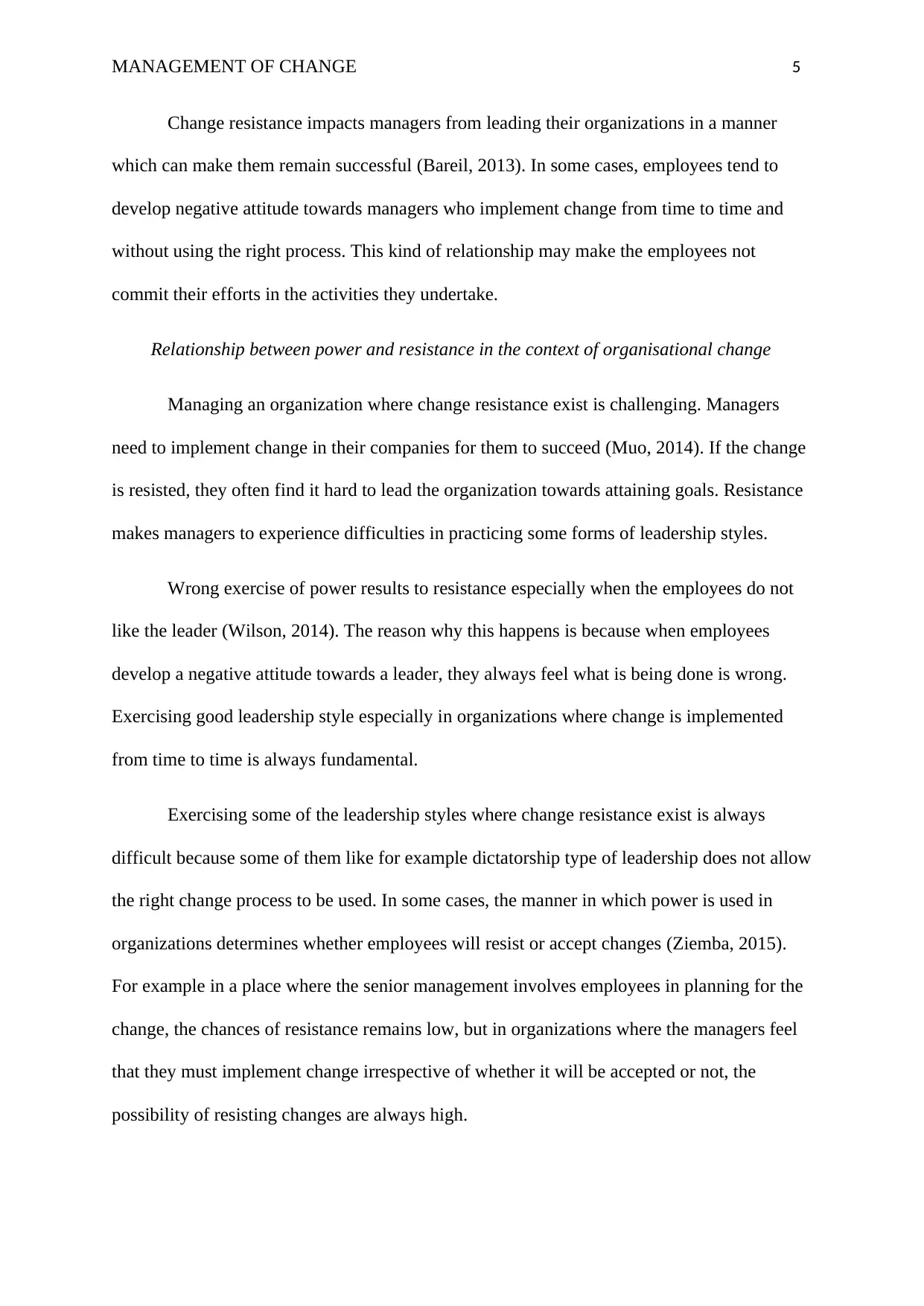
MANAGEMENT OF CHANGE 5
Change resistance impacts managers from leading their organizations in a manner
which can make them remain successful (Bareil, 2013). In some cases, employees tend to
develop negative attitude towards managers who implement change from time to time and
without using the right process. This kind of relationship may make the employees not
commit their efforts in the activities they undertake.
Relationship between power and resistance in the context of organisational change
Managing an organization where change resistance exist is challenging. Managers
need to implement change in their companies for them to succeed (Muo, 2014). If the change
is resisted, they often find it hard to lead the organization towards attaining goals. Resistance
makes managers to experience difficulties in practicing some forms of leadership styles.
Wrong exercise of power results to resistance especially when the employees do not
like the leader (Wilson, 2014). The reason why this happens is because when employees
develop a negative attitude towards a leader, they always feel what is being done is wrong.
Exercising good leadership style especially in organizations where change is implemented
from time to time is always fundamental.
Exercising some of the leadership styles where change resistance exist is always
difficult because some of them like for example dictatorship type of leadership does not allow
the right change process to be used. In some cases, the manner in which power is used in
organizations determines whether employees will resist or accept changes (Ziemba, 2015).
For example in a place where the senior management involves employees in planning for the
change, the chances of resistance remains low, but in organizations where the managers feel
that they must implement change irrespective of whether it will be accepted or not, the
possibility of resisting changes are always high.
Change resistance impacts managers from leading their organizations in a manner
which can make them remain successful (Bareil, 2013). In some cases, employees tend to
develop negative attitude towards managers who implement change from time to time and
without using the right process. This kind of relationship may make the employees not
commit their efforts in the activities they undertake.
Relationship between power and resistance in the context of organisational change
Managing an organization where change resistance exist is challenging. Managers
need to implement change in their companies for them to succeed (Muo, 2014). If the change
is resisted, they often find it hard to lead the organization towards attaining goals. Resistance
makes managers to experience difficulties in practicing some forms of leadership styles.
Wrong exercise of power results to resistance especially when the employees do not
like the leader (Wilson, 2014). The reason why this happens is because when employees
develop a negative attitude towards a leader, they always feel what is being done is wrong.
Exercising good leadership style especially in organizations where change is implemented
from time to time is always fundamental.
Exercising some of the leadership styles where change resistance exist is always
difficult because some of them like for example dictatorship type of leadership does not allow
the right change process to be used. In some cases, the manner in which power is used in
organizations determines whether employees will resist or accept changes (Ziemba, 2015).
For example in a place where the senior management involves employees in planning for the
change, the chances of resistance remains low, but in organizations where the managers feel
that they must implement change irrespective of whether it will be accepted or not, the
possibility of resisting changes are always high.
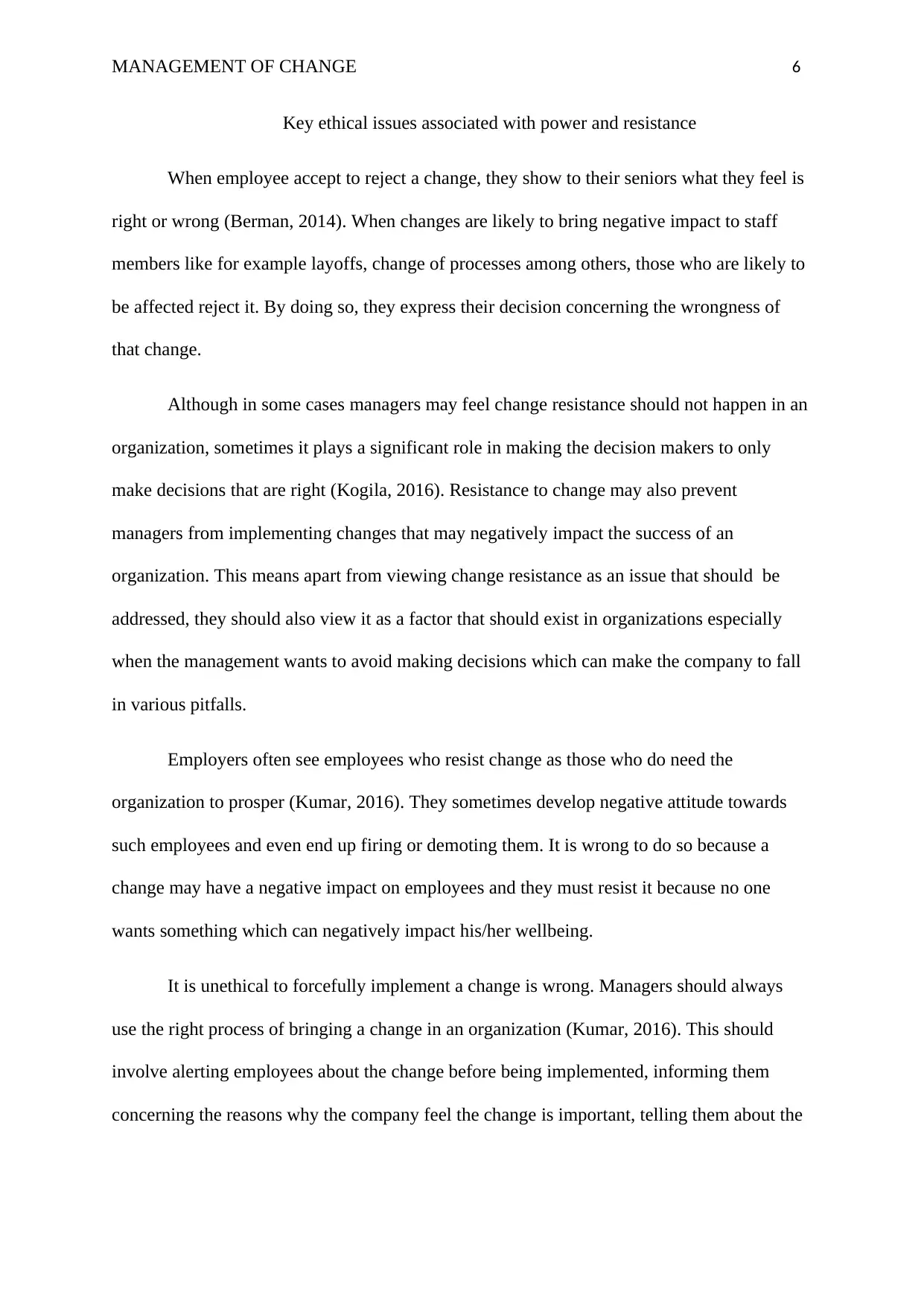
MANAGEMENT OF CHANGE 6
Key ethical issues associated with power and resistance
When employee accept to reject a change, they show to their seniors what they feel is
right or wrong (Berman, 2014). When changes are likely to bring negative impact to staff
members like for example layoffs, change of processes among others, those who are likely to
be affected reject it. By doing so, they express their decision concerning the wrongness of
that change.
Although in some cases managers may feel change resistance should not happen in an
organization, sometimes it plays a significant role in making the decision makers to only
make decisions that are right (Kogila, 2016). Resistance to change may also prevent
managers from implementing changes that may negatively impact the success of an
organization. This means apart from viewing change resistance as an issue that should be
addressed, they should also view it as a factor that should exist in organizations especially
when the management wants to avoid making decisions which can make the company to fall
in various pitfalls.
Employers often see employees who resist change as those who do need the
organization to prosper (Kumar, 2016). They sometimes develop negative attitude towards
such employees and even end up firing or demoting them. It is wrong to do so because a
change may have a negative impact on employees and they must resist it because no one
wants something which can negatively impact his/her wellbeing.
It is unethical to forcefully implement a change is wrong. Managers should always
use the right process of bringing a change in an organization (Kumar, 2016). This should
involve alerting employees about the change before being implemented, informing them
concerning the reasons why the company feel the change is important, telling them about the
Key ethical issues associated with power and resistance
When employee accept to reject a change, they show to their seniors what they feel is
right or wrong (Berman, 2014). When changes are likely to bring negative impact to staff
members like for example layoffs, change of processes among others, those who are likely to
be affected reject it. By doing so, they express their decision concerning the wrongness of
that change.
Although in some cases managers may feel change resistance should not happen in an
organization, sometimes it plays a significant role in making the decision makers to only
make decisions that are right (Kogila, 2016). Resistance to change may also prevent
managers from implementing changes that may negatively impact the success of an
organization. This means apart from viewing change resistance as an issue that should be
addressed, they should also view it as a factor that should exist in organizations especially
when the management wants to avoid making decisions which can make the company to fall
in various pitfalls.
Employers often see employees who resist change as those who do need the
organization to prosper (Kumar, 2016). They sometimes develop negative attitude towards
such employees and even end up firing or demoting them. It is wrong to do so because a
change may have a negative impact on employees and they must resist it because no one
wants something which can negatively impact his/her wellbeing.
It is unethical to forcefully implement a change is wrong. Managers should always
use the right process of bringing a change in an organization (Kumar, 2016). This should
involve alerting employees about the change before being implemented, informing them
concerning the reasons why the company feel the change is important, telling them about the
⊘ This is a preview!⊘
Do you want full access?
Subscribe today to unlock all pages.

Trusted by 1+ million students worldwide
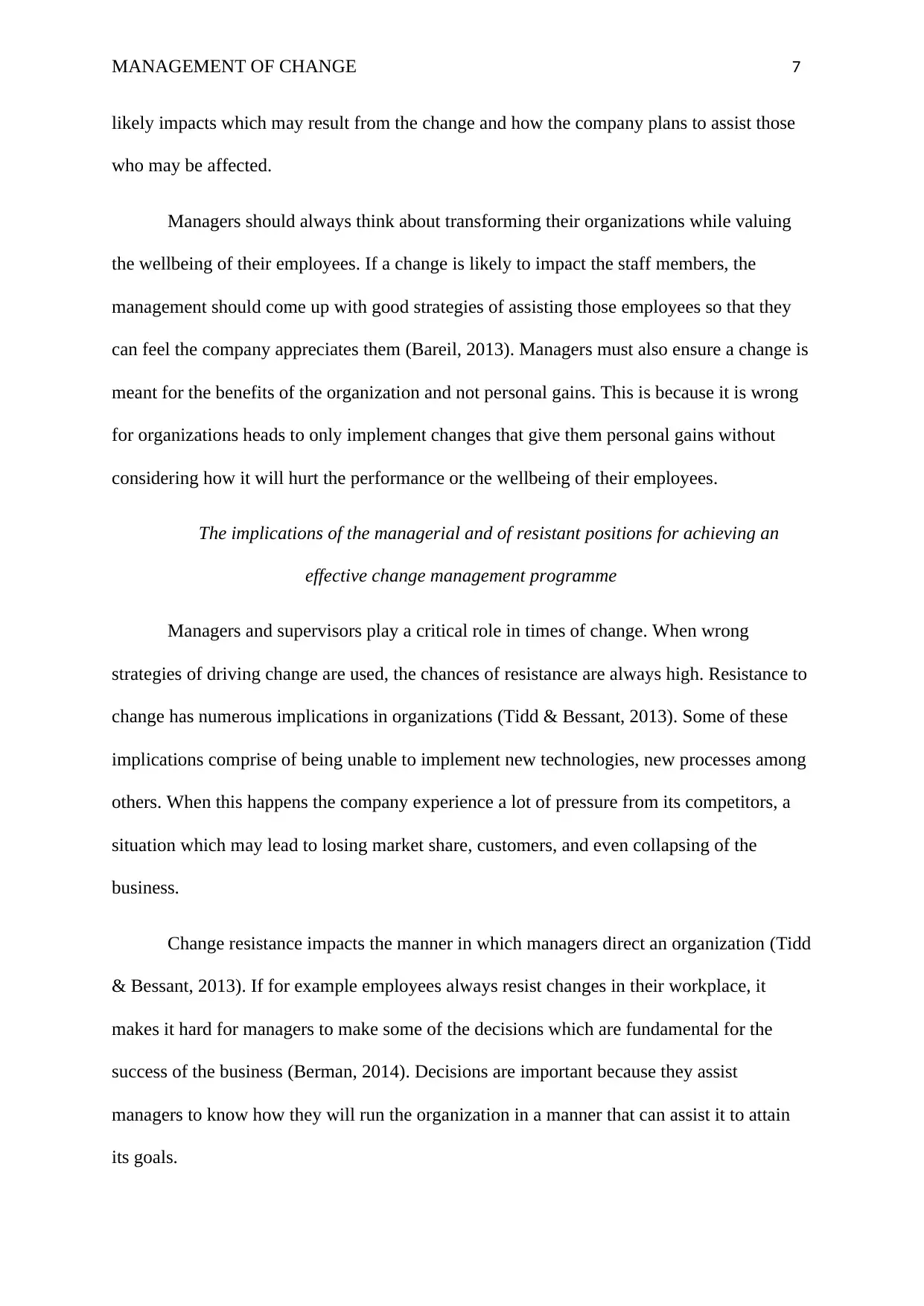
MANAGEMENT OF CHANGE 7
likely impacts which may result from the change and how the company plans to assist those
who may be affected.
Managers should always think about transforming their organizations while valuing
the wellbeing of their employees. If a change is likely to impact the staff members, the
management should come up with good strategies of assisting those employees so that they
can feel the company appreciates them (Bareil, 2013). Managers must also ensure a change is
meant for the benefits of the organization and not personal gains. This is because it is wrong
for organizations heads to only implement changes that give them personal gains without
considering how it will hurt the performance or the wellbeing of their employees.
The implications of the managerial and of resistant positions for achieving an
effective change management programme
Managers and supervisors play a critical role in times of change. When wrong
strategies of driving change are used, the chances of resistance are always high. Resistance to
change has numerous implications in organizations (Tidd & Bessant, 2013). Some of these
implications comprise of being unable to implement new technologies, new processes among
others. When this happens the company experience a lot of pressure from its competitors, a
situation which may lead to losing market share, customers, and even collapsing of the
business.
Change resistance impacts the manner in which managers direct an organization (Tidd
& Bessant, 2013). If for example employees always resist changes in their workplace, it
makes it hard for managers to make some of the decisions which are fundamental for the
success of the business (Berman, 2014). Decisions are important because they assist
managers to know how they will run the organization in a manner that can assist it to attain
its goals.
likely impacts which may result from the change and how the company plans to assist those
who may be affected.
Managers should always think about transforming their organizations while valuing
the wellbeing of their employees. If a change is likely to impact the staff members, the
management should come up with good strategies of assisting those employees so that they
can feel the company appreciates them (Bareil, 2013). Managers must also ensure a change is
meant for the benefits of the organization and not personal gains. This is because it is wrong
for organizations heads to only implement changes that give them personal gains without
considering how it will hurt the performance or the wellbeing of their employees.
The implications of the managerial and of resistant positions for achieving an
effective change management programme
Managers and supervisors play a critical role in times of change. When wrong
strategies of driving change are used, the chances of resistance are always high. Resistance to
change has numerous implications in organizations (Tidd & Bessant, 2013). Some of these
implications comprise of being unable to implement new technologies, new processes among
others. When this happens the company experience a lot of pressure from its competitors, a
situation which may lead to losing market share, customers, and even collapsing of the
business.
Change resistance impacts the manner in which managers direct an organization (Tidd
& Bessant, 2013). If for example employees always resist changes in their workplace, it
makes it hard for managers to make some of the decisions which are fundamental for the
success of the business (Berman, 2014). Decisions are important because they assist
managers to know how they will run the organization in a manner that can assist it to attain
its goals.
Paraphrase This Document
Need a fresh take? Get an instant paraphrase of this document with our AI Paraphraser
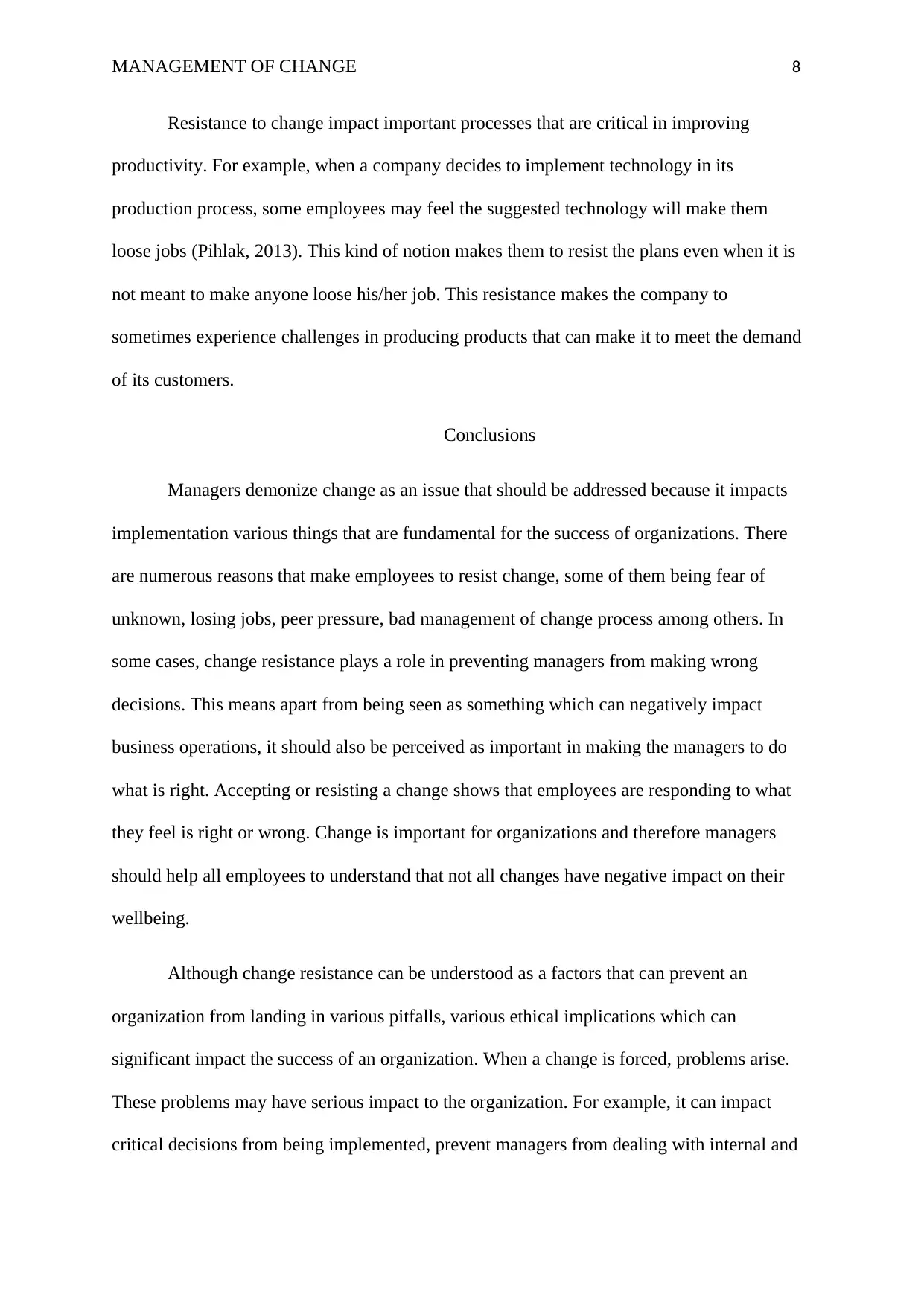
MANAGEMENT OF CHANGE 8
Resistance to change impact important processes that are critical in improving
productivity. For example, when a company decides to implement technology in its
production process, some employees may feel the suggested technology will make them
loose jobs (Pihlak, 2013). This kind of notion makes them to resist the plans even when it is
not meant to make anyone loose his/her job. This resistance makes the company to
sometimes experience challenges in producing products that can make it to meet the demand
of its customers.
Conclusions
Managers demonize change as an issue that should be addressed because it impacts
implementation various things that are fundamental for the success of organizations. There
are numerous reasons that make employees to resist change, some of them being fear of
unknown, losing jobs, peer pressure, bad management of change process among others. In
some cases, change resistance plays a role in preventing managers from making wrong
decisions. This means apart from being seen as something which can negatively impact
business operations, it should also be perceived as important in making the managers to do
what is right. Accepting or resisting a change shows that employees are responding to what
they feel is right or wrong. Change is important for organizations and therefore managers
should help all employees to understand that not all changes have negative impact on their
wellbeing.
Although change resistance can be understood as a factors that can prevent an
organization from landing in various pitfalls, various ethical implications which can
significant impact the success of an organization. When a change is forced, problems arise.
These problems may have serious impact to the organization. For example, it can impact
critical decisions from being implemented, prevent managers from dealing with internal and
Resistance to change impact important processes that are critical in improving
productivity. For example, when a company decides to implement technology in its
production process, some employees may feel the suggested technology will make them
loose jobs (Pihlak, 2013). This kind of notion makes them to resist the plans even when it is
not meant to make anyone loose his/her job. This resistance makes the company to
sometimes experience challenges in producing products that can make it to meet the demand
of its customers.
Conclusions
Managers demonize change as an issue that should be addressed because it impacts
implementation various things that are fundamental for the success of organizations. There
are numerous reasons that make employees to resist change, some of them being fear of
unknown, losing jobs, peer pressure, bad management of change process among others. In
some cases, change resistance plays a role in preventing managers from making wrong
decisions. This means apart from being seen as something which can negatively impact
business operations, it should also be perceived as important in making the managers to do
what is right. Accepting or resisting a change shows that employees are responding to what
they feel is right or wrong. Change is important for organizations and therefore managers
should help all employees to understand that not all changes have negative impact on their
wellbeing.
Although change resistance can be understood as a factors that can prevent an
organization from landing in various pitfalls, various ethical implications which can
significant impact the success of an organization. When a change is forced, problems arise.
These problems may have serious impact to the organization. For example, it can impact
critical decisions from being implemented, prevent managers from dealing with internal and
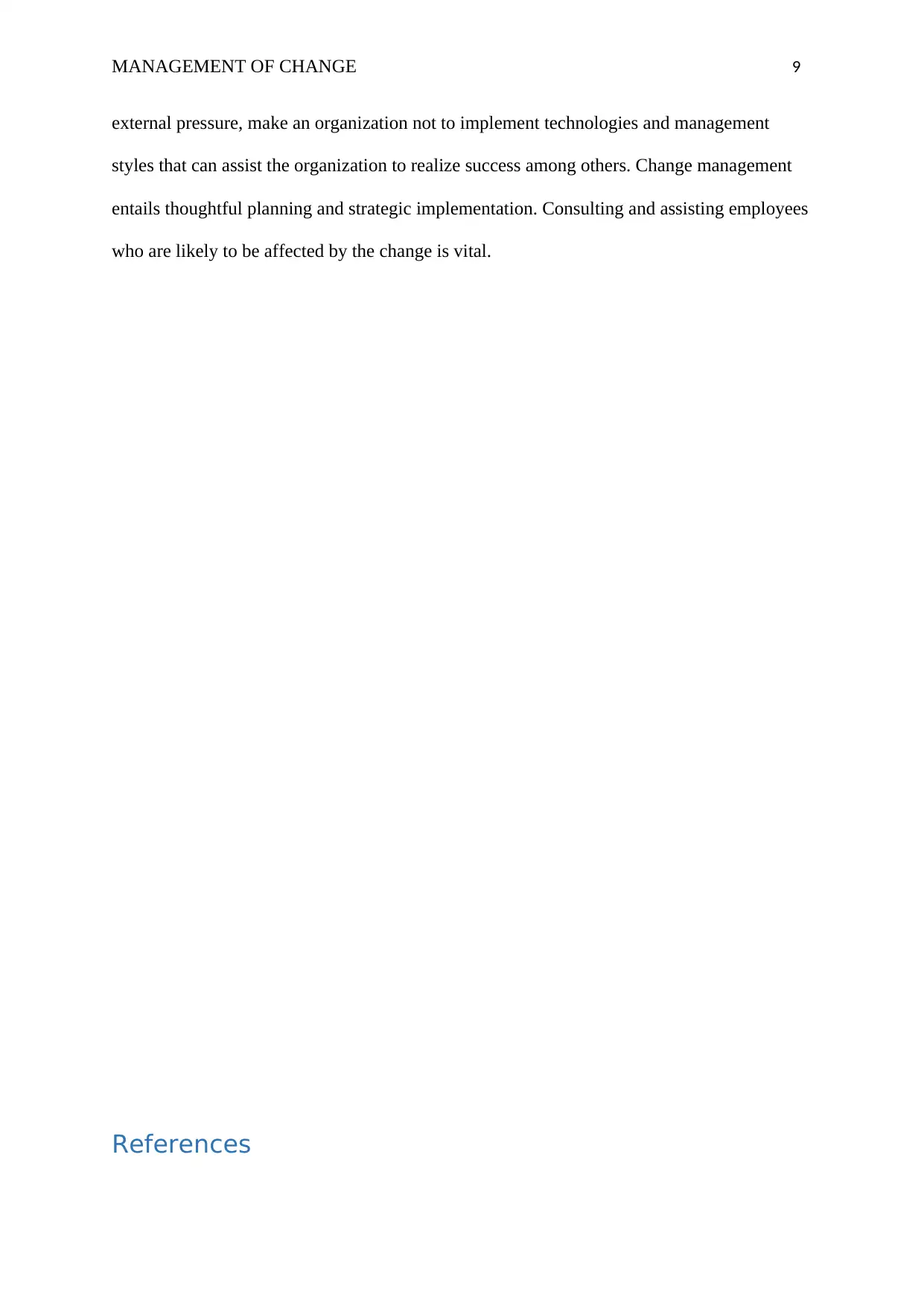
MANAGEMENT OF CHANGE 9
external pressure, make an organization not to implement technologies and management
styles that can assist the organization to realize success among others. Change management
entails thoughtful planning and strategic implementation. Consulting and assisting employees
who are likely to be affected by the change is vital.
References
external pressure, make an organization not to implement technologies and management
styles that can assist the organization to realize success among others. Change management
entails thoughtful planning and strategic implementation. Consulting and assisting employees
who are likely to be affected by the change is vital.
References
⊘ This is a preview!⊘
Do you want full access?
Subscribe today to unlock all pages.

Trusted by 1+ million students worldwide
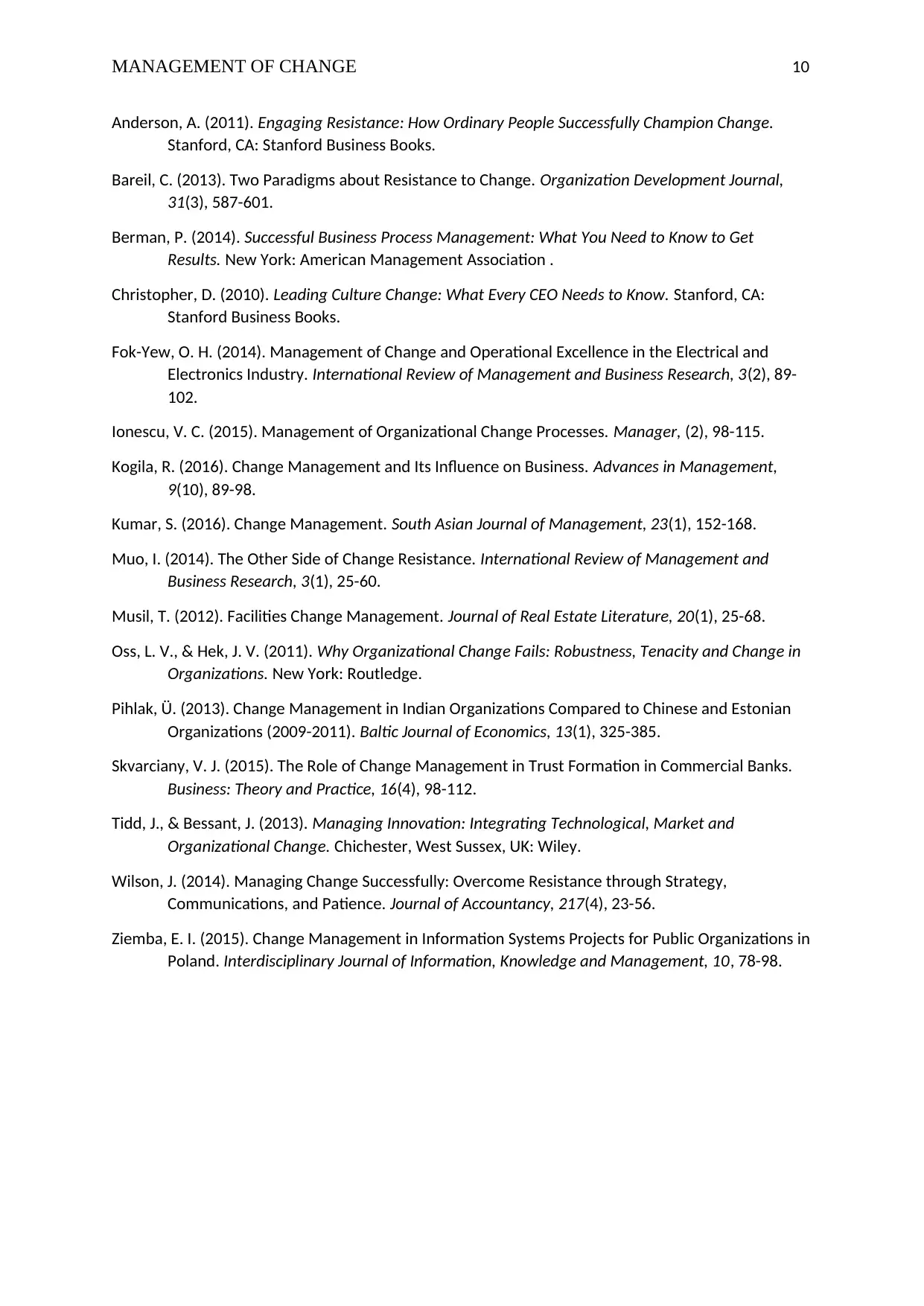
MANAGEMENT OF CHANGE 10
Anderson, A. (2011). Engaging Resistance: How Ordinary People Successfully Champion Change.
Stanford, CA: Stanford Business Books.
Bareil, C. (2013). Two Paradigms about Resistance to Change. Organization Development Journal,
31(3), 587-601.
Berman, P. (2014). Successful Business Process Management: What You Need to Know to Get
Results. New York: American Management Association .
Christopher, D. (2010). Leading Culture Change: What Every CEO Needs to Know. Stanford, CA:
Stanford Business Books.
Fok-Yew, O. H. (2014). Management of Change and Operational Excellence in the Electrical and
Electronics Industry. International Review of Management and Business Research, 3(2), 89-
102.
Ionescu, V. C. (2015). Management of Organizational Change Processes. Manager, (2), 98-115.
Kogila, R. (2016). Change Management and Its Influence on Business. Advances in Management,
9(10), 89-98.
Kumar, S. (2016). Change Management. South Asian Journal of Management, 23(1), 152-168.
Muo, I. (2014). The Other Side of Change Resistance. International Review of Management and
Business Research, 3(1), 25-60.
Musil, T. (2012). Facilities Change Management. Journal of Real Estate Literature, 20(1), 25-68.
Oss, L. V., & Hek, J. V. (2011). Why Organizational Change Fails: Robustness, Tenacity and Change in
Organizations. New York: Routledge.
Pihlak, Ü. (2013). Change Management in Indian Organizations Compared to Chinese and Estonian
Organizations (2009-2011). Baltic Journal of Economics, 13(1), 325-385.
Skvarciany, V. J. (2015). The Role of Change Management in Trust Formation in Commercial Banks.
Business: Theory and Practice, 16(4), 98-112.
Tidd, J., & Bessant, J. (2013). Managing Innovation: Integrating Technological, Market and
Organizational Change. Chichester, West Sussex, UK: Wiley.
Wilson, J. (2014). Managing Change Successfully: Overcome Resistance through Strategy,
Communications, and Patience. Journal of Accountancy, 217(4), 23-56.
Ziemba, E. I. (2015). Change Management in Information Systems Projects for Public Organizations in
Poland. Interdisciplinary Journal of Information, Knowledge and Management, 10, 78-98.
Anderson, A. (2011). Engaging Resistance: How Ordinary People Successfully Champion Change.
Stanford, CA: Stanford Business Books.
Bareil, C. (2013). Two Paradigms about Resistance to Change. Organization Development Journal,
31(3), 587-601.
Berman, P. (2014). Successful Business Process Management: What You Need to Know to Get
Results. New York: American Management Association .
Christopher, D. (2010). Leading Culture Change: What Every CEO Needs to Know. Stanford, CA:
Stanford Business Books.
Fok-Yew, O. H. (2014). Management of Change and Operational Excellence in the Electrical and
Electronics Industry. International Review of Management and Business Research, 3(2), 89-
102.
Ionescu, V. C. (2015). Management of Organizational Change Processes. Manager, (2), 98-115.
Kogila, R. (2016). Change Management and Its Influence on Business. Advances in Management,
9(10), 89-98.
Kumar, S. (2016). Change Management. South Asian Journal of Management, 23(1), 152-168.
Muo, I. (2014). The Other Side of Change Resistance. International Review of Management and
Business Research, 3(1), 25-60.
Musil, T. (2012). Facilities Change Management. Journal of Real Estate Literature, 20(1), 25-68.
Oss, L. V., & Hek, J. V. (2011). Why Organizational Change Fails: Robustness, Tenacity and Change in
Organizations. New York: Routledge.
Pihlak, Ü. (2013). Change Management in Indian Organizations Compared to Chinese and Estonian
Organizations (2009-2011). Baltic Journal of Economics, 13(1), 325-385.
Skvarciany, V. J. (2015). The Role of Change Management in Trust Formation in Commercial Banks.
Business: Theory and Practice, 16(4), 98-112.
Tidd, J., & Bessant, J. (2013). Managing Innovation: Integrating Technological, Market and
Organizational Change. Chichester, West Sussex, UK: Wiley.
Wilson, J. (2014). Managing Change Successfully: Overcome Resistance through Strategy,
Communications, and Patience. Journal of Accountancy, 217(4), 23-56.
Ziemba, E. I. (2015). Change Management in Information Systems Projects for Public Organizations in
Poland. Interdisciplinary Journal of Information, Knowledge and Management, 10, 78-98.
1 out of 10
Related Documents
Your All-in-One AI-Powered Toolkit for Academic Success.
+13062052269
info@desklib.com
Available 24*7 on WhatsApp / Email
![[object Object]](/_next/static/media/star-bottom.7253800d.svg)
Unlock your academic potential
Copyright © 2020–2025 A2Z Services. All Rights Reserved. Developed and managed by ZUCOL.





